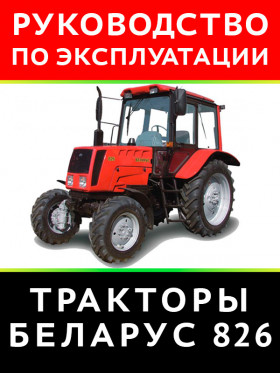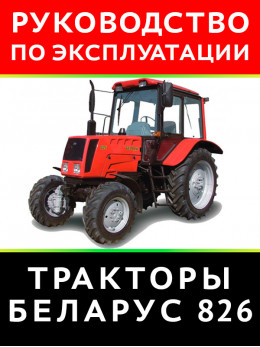Tractor Belarus 826, owners and maintenance e-manual (in Russian)
About the manual
Engine type: D-243 / 243s
Engine power: 60 kW
In the manual you will find
- Information on self-service tractor
- Information on the design of the tractor and how to prevent failure
- The information for the trip to the service station, if the self-repair is impossible
About the manual
Engine type: D-243 / 243s
Engine power: 60 kW
In the manual you will find
- Information on self-service tractor
- Information on the design of the tractor and how to prevent failure
- The information for the trip to the service station, if the self-repair is impossible
Contents
For operator's attention
Introduction
- Accepted abbreviations and conventions
- International characters
Precautions
- General provisions
- Safety requirements for tractor operation
- Safety requirements during maintenance
- Safety requirements for the operation and maintenance of electrical equipment
- Hygiene requirements
- Fire safety requirements
General information
- Serial numbers of tractor parts
- Diesel and its systems
- Technical data of units
- Gearbox
- Gear shifting mechanism
Controls and instrumentation
- Controls located at the top of the cab
- Controls and instruments located on the dashboard
- Pedals
- Controls and levers located on the right side console and in the cab
- Starter switch and instruments
- Instrument cluster
- Combined indicator AR80.3813
- AR80.3709 indicator control panel. IC programming
- The principle of operation of the switches located in the upper part of the cab
- Control lamp block
- Fuses
- Connecting elements of electrical equipment
- Handles, switches and levers, their purpose
- Remote control of hydraulic distributor
- Seat, seat adjustment
- Grammer seat
Operating instructions
- Preparing the tractor for work
- Running in
- Diesel launch
- Startup under normal conditions
- Starting at low temperatures (+ 4 ° С and below)
- The procedure for starting a diesel engine at low temperatures
- Starting the tractor movement
- Stopping the tractor
- Stopping the diesel
- Steering
- Shifting the transmission with reverse gear
- Hydraulic system
Aggregation
- Attachments for coupling agricultural machines to a tractor
- Rear hitch of tractors equipped with a hydraulic lift
- Attaching machines to a tractor
- Control of the hydraulic system and the hinged device of a tractor without a power regulator
- Operation of a tractor equipped with a hydraulic lift pump
- Features of the tractor operation with machines requiring a drive from the rear PTO shaft
- Tires
- Trailer brake pneumatic control
Adjustments
- Setting the front wheel track
- Toe-in front wheels
- Setting the rear wheel track
- Power take-off shaft adjustment
- Adjustment of FDA drive transfer case control rod
Scheduled maintenance
- Types of tractor maintenance
- Maintenance while preparing the tractor for running-in
- Maintenance during break-in
- Maintenance after running-in (30 hours of operation)
- Lubrication and maintenance chart
- Maintenance table
- Every 10 hours of operation or daily
- After every 125 hours of operation, perform the previous maintenance plus the following
- After every 250 hours of operation, perform the previous maintenance plus the following
- After every 500 hours of operation, perform the previous maintenance operations plus the following
- After every 1000 hours of operation, perform the previous maintenance operations plus the following
- After every 2000 operating hours, perform the previous maintenance plus the following
- General maintenance
- Seasonal maintenance
- Lubrication table
- Refueling tanks
- Adjustment parameters
Possible malfunctions and how to fix them
- Diesel
- Clutch
- Differential lock
- Front drive axle
- Hydrostatic steering
- Hydraulic linkage system
- Electrical equipment
- Cabin heating and ventilation unit
- Pneumatic system
Tractor transportation and towing
Tractor storage
Tractor recycling
Electrical equipment






